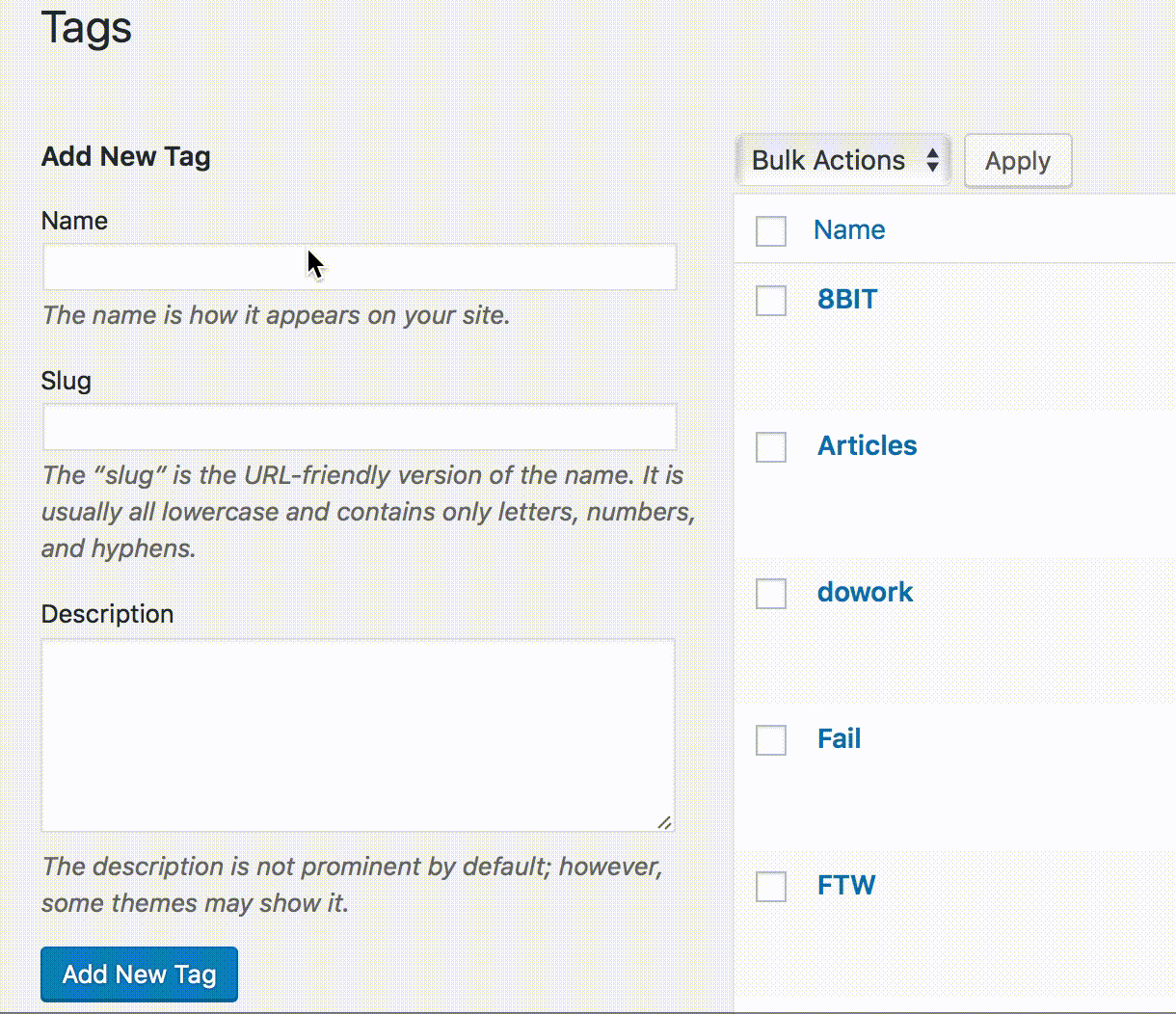I'm pretty new to WordPress, but basically what I'm trying to achieve is to make a tag's description a required field on my custom theme for WordPress 4.5.2
I've tried three approaches, but all of them failed so if anyone WordPress expert out there could guide me would be nice.
I've tried to 'edit' the hook when the edit_tag_form_fields and add_tag_form hook is called, then modify via Javascript
function require_category_description(){
require_once('includes/require_category_description.php');
}
add_action('edit_tag_form_fields', 'require_category_description');
add_action('add_tag_form', 'require_category_description');
<script>
jQuery(document).ready(function(){
var description = jQuery('#tag-description');
if(!description) description = jQuery('#description');
if(description){
description.parents('form').submit(function(){
if(description.val().trim().length < 1){
console.log('Please enter a description...');
return false;
}
});
}
});
</script>
It was not working, the form was submitting even though the description field was empty, and above all, the console.log inside the event listener never happened. I've tried to log the description variable to make sure it's going inside the if case. Therefore, I assumed the form was never submitting, and the whole 'submission' is done via Ajax, on the button click.
The functions.php remains the same as approach #1, but I've made some changes Javascript wise to target the button click event instead of the form submit event.
<script>
jQuery(document).ready(function(){
var description = jQuery('#tag-description');
if(!description) description = jQuery('#description');
if(description){
var button = description.parents('form').find('#submit');
button.on('click', function(e){
if(description.val().trim().length < 1)
console.log('Please enter a description...');
e.preventDefault();
return false;
});
}
});
</script>
The form is however still submitting, but this time, I see the console log message.
Please enter a description...
My theory is that WordPress is binding an event to the button's click before my event, so it's processing the built-in event with Ajax before going to my custom click event.
I've tried to unbind the click events from my button before adding my own click event.
<script>
jQuery(document).ready(function(){
var description = jQuery('#tag-description');
if(!description) description = jQuery('#description');
if(description){
var button = description.parents('form').find('#submit');
button.unbind('click');
button.on('click', function(e){
if(description.val().trim().length < 1)
console.log('Please enter a description...');
e.preventDefault();
return false;
});
}
});
</script>
The result is the same as approach #2. The form is still submitting, but I see the console log message.
The meta description meta tag is also added in the "head" section of your HTML. <meta name="description" content="sample meta description."> While meta descriptions are not a direct Google ranking factor, the can affect a page's click-through rate and thus improve search rankings.
Open the HTML file and locate the <head> section near the top of the file. Depending on how you created the page, there may already be a title and some other meta content. The title is between HTML <title></title> tags. The description and keywords are entered in <meta> tags.
Edit tag:
When editing tag, WordPress call wp_update_term. But there're no filters or AJAX call, so we must use get_term() which is called by wp_update_term():
add_filter('get_post_tag', function($term, $tax)
{
if ( isset($_POST['description']) && empty($_POST['description']) ) {
return new \WP_Error('empty_term_name', __('Tag description cannot be empty!', 'text-domain'));
} else {
return $term;
}
}, -1, 2);
We also need to update term_updated_message to make the error clear:
add_filter('term_updated_messages', function($messages)
{
$messages['post_tag'][5] = sprintf('<span style="color:#dc3232">%s</span>', __('Tag description cannot be empty!', 'text-domain'));
return $messages;
});
Because WordPress hardcoded the notice message div, I used inline css to make the error look like a waring. Change it to your preference.
Add new tag:
The AJAX request calls wp_insert_term so we can use pre_insert_term filter. Try this in your functions.php
add_filter('pre_insert_term', function($term, $tax)
{
if ( ('post_tag' === $tax) && isset($_POST['description']) && empty($_POST['description']) ) {
return new \WP_Error('empty_term_name', __('Tag description cannot be empty!', 'text-domain'));
} else {
return $term;
}
}, -1, 2);
Here I used the built-in empty_term_name error to show notice message but you should register your own one.
Also, take a look at wp_ajax_add_tag to fully understand what we're doing.

If you love us? You can donate to us via Paypal or buy me a coffee so we can maintain and grow! Thank you!
Donate Us With